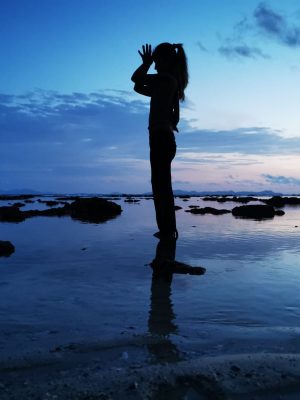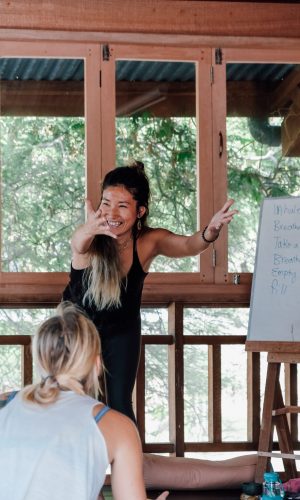Yoga for Military
Healing Our Modern Hearts
Okinawa, Japan is the southern most prefecture off the coast of mainland Japan. When you land here, many people are often surprised to see so many American military bases. In the south, bases like Kadena or Camp Courtney are in cities but in the north, there are bases like Camp Schwab that is closer to green forests and wilder nature of Okinawa waterfalls and deserted beaches that offers a little more chances of seeing those typical country sides of Okinawa that you might have seen in pictures.
Prior to moving to Okinawa, I never really had a close contact with military personnel in or outside of Japan. But I do recall, a few times, going to Yokosuka Base to stay for a few nights with an American family as part of English learning school. But other than that, I know nothing of what it means to be military or their families.
But what I can share is what I witnessed during many of my private yoga sessions that seem to have the real need for yoga practice that goes beyond āsana (postures). And I believe the lifestyle and symptoms I discuss here are not limited to military personnels. Anyone with high pressure jobs, or modern lifestyles can have the similar symptoms that have often become a norm in any societies.
It’s been 4 years since I moved to Okinawa and my yoga client base is mixed with Japanese and Americans with occasional tourists. The American people who come to see me for yoga are often people who are not interested in group yoga classes, nor fancy acrobatic like poses. They are under tremendous amount of pressure on a daily basis and what they crave is to regain their ability to switch off their sympathetic nervous system, relax on a deeper level, reset their sleep patterns, regain their own ability to heal inside and outside. A lot of them have been injured during active duties or trainings and while they have great doctors on the base, they are looking to regain strength that is sustainable while they heal.
The military training already keeps them in better shape than hockey players so our focus is on deeper tissue releases and nervous system resetting.
Their lifestyle of being “on call” keeps them on high alert in their nervous systems. And when the nervous system is on alert at all times, the deeper tissues in their bodies become tight, then numb much like a fist that was never opened for hours. Before we begin our private yoga sessions, I often tell them it requires commitment and patience because the results don’t show immediately on the mat (as in “hey, you’re doing the headstand!”) and if they don’t stick to it, like the unopened fist that was forced to open, their bodies and habitual patterns in their lifestyles return. Luckily, people in the military are great with commitment and patience. But it does take getting used to because it is quite different from our usual constant method of “working hard at it.” In fact, we are working hard to kick the habit of working hard.

Where they actually see the result is off the mat, in their sleep patterns, eating habits, alcohol intake, stress levels at work, general calmer and more stable inner landscapes and relationships. I’ve had people deal with deep traumas or release from their debilitating anxiety during our sessions simply because our yogic practice allows them to do so.
We are basically resetting how our nervous systems work through ancient practice but I hesitate to use the word, nervous systems because it makes humans more mechanical. My teacher even scoffs the modern term “bio-hacking” because we are “not machines to be hacked” and I completely agree.
But I’m told that it is part of military discipline to somewhat make one like a machine to numb their senses, to “suck it up” and “soldier on”.
When I heard this, I could see why yoga is needed in our world. Even if you’re not part of military or their families, we have certainly been living under pressure. The 1939 British slogan of “keep calm and carry on” somehow managed to creep up to 2024 in different variations, showing up in mugs and doormats, almost subconsciously being persuaded to push our limits, shove down our feelings and move on.
In yoga, human beings are not machines to fix and repair. Nervous systems are part of important energetic fields that cannot be separated from mental or physical parts of us. Mysticism of being a human being cannot be omitted when it comes to yoga.
Researchers have also been looking at benefits of yoga in the military.
- Effective in treating PTSD (*1)
- Improves executive function by attenuating stress levels (*2)
- Improves resilience and readiness (*3)
- Beneficial with inflammatory chronic pains (*4)
I believe the way yoga views human beings is the reason why yoga can be so healing. It’s the opposite of what we have been taught to do, and certainly the opposite of “keeping calm and carrying on.” Yoga does not let us keep calm or stay blissed out and ignore the rest just to carry out our daily tasks. Yoga, taught rooted in tradition, forces us to dig deeper at precisely the right moment when we are ready. As we learn to intentionally breathe and ground us, yoga prepares us for a gentle waking moment. That is what I call healing.
So my yoga sessions with people with such lifestyles have nothing to do with headstand or pigeon poses. I focus on going within, through intentional breathing and methodical meditation, deep tissue release and yogic relaxation techniques. Downward facing dog and sphinx pose are great for our bodies but if we are not cultivating a deeper root, a stable home within, then these poses are just empty exercises that many people just fall into their perpetual habit of “getting good at”, another example of accomplishment culture in our societies.
What I see also is there seems to be a real shame in dealing with traumas, fear, depression or anxiety. Tending to our emotional well-being somehow makes one weak, or too sensitive to deal with realities. What I truly believe is that our emotional well-being IS the reality that is going on. We may not be able to map it in our bones and muscles but our emotional, mental well-being is as real as it gets in human lives. In fact, it is so real that when we face what we perceive to be dangerous, potentially traumatic events, our nervous systems automatically switch to sympathetic nervous system, either throwing us into a total panic or utterly dissociating from our emotions. When this situation continues or is repeated, we often find ways to be able to continue on a surface level, going through day to day activities. And our deeper tissues and emotional pathways tighten, harden, unable to find relief at all times.

Yoga does not see us like we do. We are not just bones and muscles with a bit of emotions and brain processes. Yoga sees humans of many layers including muscles and bones. So what Yoga teaches us is, instead of shoving your emotions down your throat, tune into the emotional responses to adverse events in our lives as clues for us to process realities. By connecting to our feelings or responses to events and circumstances, we are better equipped to handle situations in our life’s events. In yoga, connecting with our feelings is the surest way to find stability within us, so that when we need to relax and rest, we can, but when we need to be alert, we are.
Unfortunately, we need time to practice responding in this way just as it takes time and repetition to create a constantly stressful lifestyle. We must first learn to know what we are truly feeling in any given moment. And this very act of trying to connect with our feelings allows us to feel safe, secure and grounded in our core beings as though we gave permission to express truly to ourselves. The more we learn about our inner landscapes, the more relaxed we feel in our core, the more untangled and released you feel in your bodies. People often mistake when they are learning to meditate that their bodies have to be set up, tight, disciplined and hard. In fact, in order to mediate, our bodies need to be relaxed. Our relaxed postures allow us to meditate longer and expand into our mental depth.
The stress we discuss here is not just limited to military personnels. Our current lives can be overwhelming and traumatic. There are wars going on in various parts of the world as we speak, people are starving while a few handful of rich people waste their food on fine dining and the environment of this planet is shifting so rapidly that we can’t seem to pinpoint what went wrong. We went through a global epidemic and were locked inside our homes for a time and as a result, our younger generations are growing up knowing anxiety and depression on a regular basis.
It’s a lot.
And of course, every generation had its own challenges but this is the one we live in now. And it needs a real and deep release. We need more time spent observing our inner landscapes. To sit quietly and check-in with our feelings, to rest deeply and find stability.
And to do that, we need to spend more time being receptive towards our inner selves and release the deepest layers of our beings through practices like yoga because a practice that is rooted in ancient traditions give us much needed relief in modern societies. These ancient methods have been tested for generations through the ages of the world. We only need to be willing to receive the healing power of yoga.

Hi, My name is Tomomi. I’ve been teaching yoga in different parts of the world for 16 years to people with different backgrounds and belief systems. It is my passion to teach yoga that doesn’t end in postures and exercises. When I was studying for B.Sc(Psych) in a university in Canada, I met yoga. I was lucky to have been taught by countless teachers who were rooted in traditions that did not forget yogic philosophy.
Now, I use their teachings daily through my private yoga sessions or yogic counseling sessions.
My sessions are either online or in-person.
If you are interested, you can have a look HERE.
References
*1 – Chopin, S. M., Sheerin, C. M., & Meyer, B. L. (2020). Yoga for warriors: An intervention for veterans with comorbid chronic pain and PTSD. Psychological trauma: theory, research, practice and policy, 12(8), 888–896. https://doi.org/10.1037/tra0000649>
*2 – Gothe NP, Keswani RK, McAuley E: Yoga practice improves executive function by attenuating stress levels. Biol Psychol 2016; 121(Part A): 109–16. [PubMed] [Google Scholar]
*3 – Joshi, A.V. (2019, February). Warrior Pose: Building Readiness through Resilience – Yoga and Meditation. Joint Special Operations University: College of Special Operations. JSOU Press.
*4 – Djalilova, D. M., Schulz, P. S., Berger, A. M., Case, A. J., Kupzyk, K. A., & Ross, A. C. (2019). Impact of Yoga on Inflammatory Biomarkers: A Systematic Review. Biological research for nursing, 21(2), 198–209. https://doi.org/10.1177/1099800418820162
